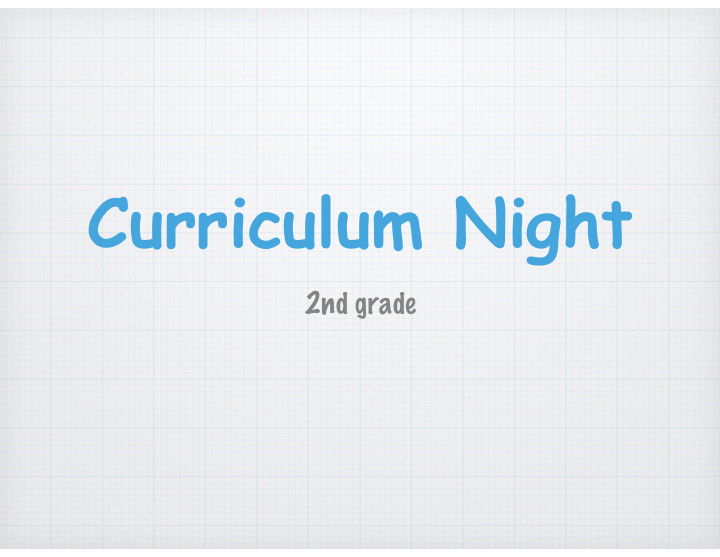



Curriculum Night 2nd grade
2nd grade Communication Please check take home folder every night Send in note if dismissal plans are going to change Check in at the office and get visitors badge when entering the school Send lunch money in envelopes provided by school Book Orders - make checks out to Scholastic Book Clubs
PBIS PBIS stands for Positive Behavioral Intervention and Supports School-wide rules and procedures are taught and practiced Blue wave tickets emphasize positive reinforcement outside the classroom Safe, Respectful, Responsible Data driven program, research based
Daily Schedule Morning Routine Acceleration Groups Morning Meeting Writing Workshop Snack break Math Special Recess/Lunch Reading Workshop/Phonics Reading Workshop
Acceleration Groups 30 minutes, 4 x per week lasts 4-6 weeks data driven flexible groupings aimed to provide acceleration in specific skills for all students
Writing Workshop Learning Outcomes: Exposure to: Personal Narratives, Nonfiction, Story adaptations, Poetry, Friendly Letters & Opinion Writing Writing Process: taking the child through generating ideas, drafting, revision & publishing Writing Mechanics: Standard capitalization, punctuation & spelling of high frequency words (using “kid friendly / phonetic spelling on challenging words) Responding to writing prompts How you can help out at home: Telling and retelling stories Reading a wide variety of genres Writing with your child; having your child write the grocery list, to-do list or postcards to family/friends
Math Workshop Learning Outcomes: Adding & subtracting 2 digit and 3 digit numbers up to 1000, which may involve regrouping numbers Tell and write time to 5 min intervals and counting coins (up to and over a dollar) Increasing the fluency of addition & subtraction facts up to 20 by the end of the school year Writing mathematical equations & explaining their thinking, including word problems Using mathematical vocabulary - greater than, less than, digits, total, place value, sum, equals, doubled, altogether Knowing the place value of numbers up to 1000 Measuring the length of an object using 2 different tools Knowing if a group of objects(up to 20) is odd/ even How you can help out at home: Skip counting 2’s, 5’s and 10’s, Counting coins, telling time, playing the games, making kids explain their thinking, measuring with cooking/baking
Reading Workshop Reading Workshop Read to Self, Read to Someone, Word Work, Writing Learning Outcomes: Read everyday, talk about books, make careful book choices and develop a willingness to read in a variety of genres. Build comprehension by using a variety of strategies Develop accuracy by using tools to figure out tricky words Develop fluency by practicing oral reading Expand vocabulary by exposure to a wide variety of genres and topics How you can help out at home: Reading at home should be SUCCESSFUL not stressful, have fun!, read every night, talk about the stories
I.B. P . O . I Learner Profile Attributes (LPA): knowledgeable, thinker, communicator, caring, principled, inquirer, reflective, courageous, balanced, open-minded I.B. Units: Everything in its place The moral of the story is... What makes a Hero? States of Matter Earth changes Can’t live without you
Spanish 30 min. a week Teaching how to be a language learner using Comprehensible Input (CI) Movement (Total Physical Response) Connections - Recognizing Cognates Acquiring High Frequency words Acquisition vs. learning - the way babies learn a language (Krashen’s Theory) Phases during acquisition: Comprehension - silent period One word production Mini sentences Telegram sentences Language bloom Students will: acquire high frequency Spanish vocabulary (songs, gestures, reading, story -asking, acting and repetition) exposure to spoken and written Spanish completing worksheets to compliment learning and showing comprehension
Recommend
More recommend